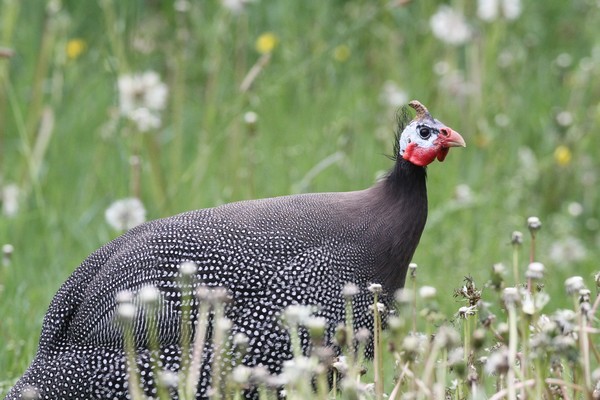Birdfinding.info ⇒ The North African form of Helmeted Guineafowl has a questionable status: thought to be extinct in the wild, but likely extant in dilute form in domestic and feral populations, possibly extant but unconfirmed as an introduced species on Barbuda, and possibly not different enough to be classified separately from the closely related “West African Guineafowl” (N. m. galeatus). Feral guineafowl in the vicinity of Rabat, Morocco, may be primarily descended from the ancestral “Moroccan” form (N. m. sabyi).
“Moroccan Guineafowl”
Numida meleagris sabyi
Formerly endemic to North Africa, and ultimately confined to northwestern Morocco. Widely regarded as extinct in the wild, but perhaps still extant in feral, naturalized, or domestic populations.
The last known wild population persisted in northwestern Morocco between the Oum Er-Rbia and Sebou Rivers (inland from Rabat) until at least the 1950s, with sightings reported into the 1970s. Additional records from the 2000s in the same general area may represent feral populations of mixed ancestry.
It may still persist elsewhere as the result of introductions. In particular, the guineafowl introduced to Barbuda were reportedly sabyi, although the original source of this information is not available for assessment, and there seem to be no public records of any attempt to verify the appearance of the Barbuda population.
Records that survive from the Roman Empire indicate that it occupied much of North Africa, at least from Morocco to Tunisia.
Identification
Images that can reliably be identified as “Moroccan Guineafowl” are not readily available, and the descriptions provided by authoritative sources leave some doubts unresolved. “Moroccan” closely resembled the “West African Guineafowl” (and might conceivably be best regarded as a localized morph of it rather than as a divergent taxon), but differed somewhat in the males’ head ornamentation.
Both “Moroccan” and “West African” can be distinguished from other forms of Helmeted Guineafowl by the color and shape of its bare parts: pale-blue-to-whitish facial skin; plump red wattles on the cheeks; and a small brownish horn or casque on the crown.

“Moroccan Guineafowl,” N. m. sabyi—attributed to sabyi, possibly feral or domestic in the photographer’s judgment. (Sidi Bou Ghaba, Kenitra, Morocco; April 8, 2015.) © Stanislav Harvančík
“Moroccan” reportedly differed from “West African” in that fully mature males had a taller casque and a patch of long spindly black feathers on the back of the head, which pointed upward and forward over the casque. (This appearance is similar to some domestic guineafowl—which may include a significant component of “Moroccan” genes.)
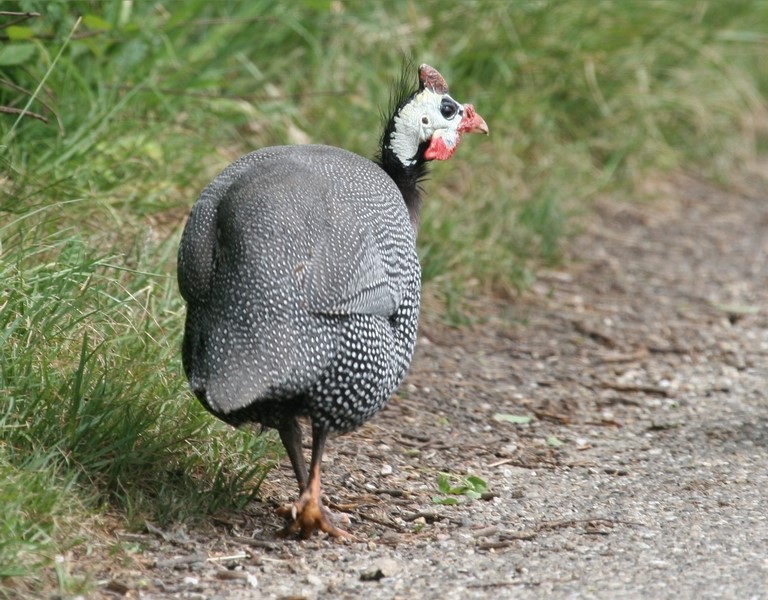
“Moroccan Guineafowl,” N. m. sabyi—attributed to sabyi, but location not specified—note that feathers on hindcrown extend above the peak of the casque. (May 18, 2008.) © Wiepko Lubbers
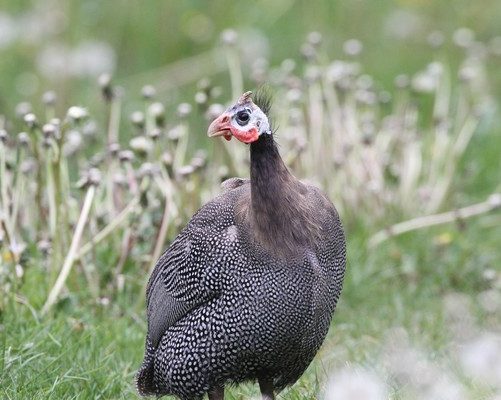
“Moroccan Guineafowl,” N. m. sabyi—attributed to sabyi, but location not specified. (May 15, 2011.) © voyageschezlesoiseaux
Cf. Other Helmeted Guineafowl. The forms of Helmeted Guineafowl are usually distinguishable based on the color and shape of the bare parts—although there is some internal variation within each form, as well as hybridization and some degree of apparent intergradation.
“Moroccan” has a small brown casque with elongated, upward-pointing feathers on the back of the head, whitish facial skinwhitish facial skin, and a “handlebar moustache” that consists of a long, broad, curled red wattle on each cheek, and a fleshy red connection across the cere.
“West African” has a small brown casque, whitish facial skin, and a “handlebar moustache” that consists of a long, broad, curled red wattle on each cheek, and a fleshy red connection across the cere.
“Ethiopian” has a small-to-medium-sized brown casque, bluish facial skin, and a cluster of bristles on the cere.
“Reichenow’s” has a very tall orange-brown casque, turquoise facial and neck skin, a black dewlap, and a “handlebar moustache” that consists of a long, broad, curled red wattle on each cheek, and a fleshy red connection across the cere.
“Tufted” has a tall orange-brown casque with a red base, red cere, turquoise facial and neck skin, a dark-blue or violet dewlap, and long, thin, pointed cheek-wattles that are bluish with red tips.
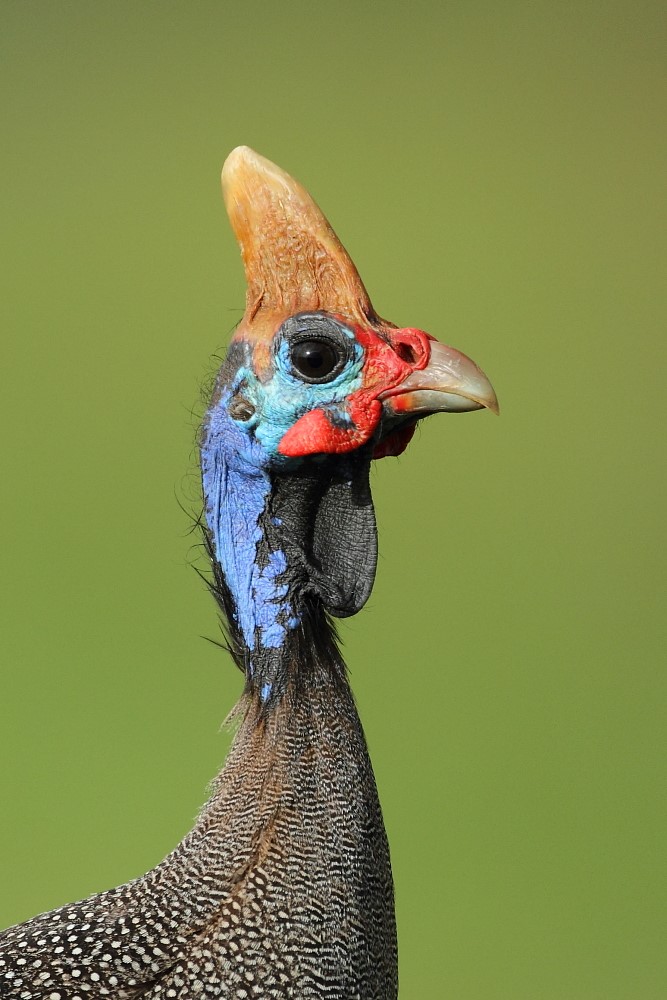
“Reichenow’s Guineafowl,” N. m. reichenowi, the champion of helmets, showing its distinctively tall orange-brown casque, red caruncles, turquoise cheeks, purplish neck-skin, and black dewlap. (Tarangire National Park, Tanzania; February 2, 2013.) © Darran Rickards
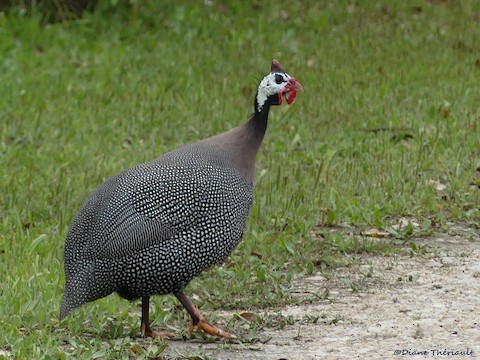
“West African Guineafowl,” N. m. galeatus, showing distinctive white facial skin, small casque, and red “handlebar moustache.” (Goose Island State Park, Texas; April 1, 2019.) © Diane Thériault
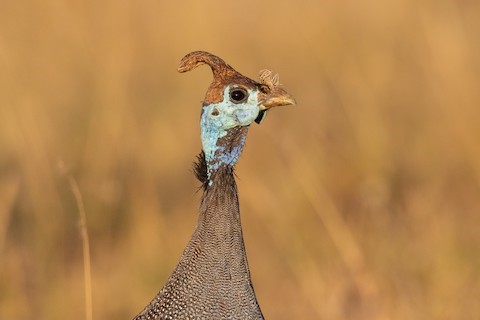
“Ethiopian Guineafowl,” N. m. meleagris, showing its small brown casque, bluish facial skin, and cluster of bristles on the cere. (Yabello, Oromia, Ethiopia; December 30, 2019.) © Stefan Hirsch
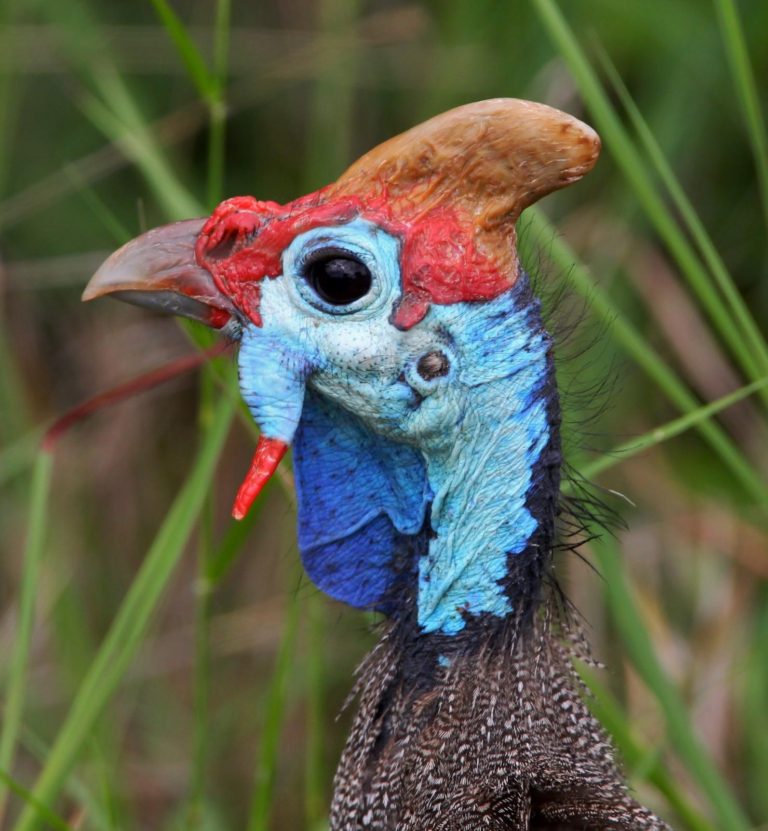
“Tufted Guineafowl,” N. m. mitratus, showing its orange-brown casque with a red base, red cere, turquoise facial and neck skin, a dark-blue dewlap, and long, thin cheek-wattles that are bluish with red tips. (Kruger National Park, South Africa; April 18, 2019.) © Guenther Karmann
Notes
Monotypic form. One of five potentially distinct forms of Helmeted Guineafowl (Numida meleagris). See Frontiers of Taxonomy: The Many-Helmeted Guineafowl, an Awkward Foursome.
The status of “Moroccan Guineafowl” (N. m. sabyi) is questionable in at least four ways: (1) it is generally presumed to be extinct; (2) it may still persist through introduced populations—on Barbuda and conceivably elsewhere—but this remains uncorroborated; (3) it may be best regarded as a subspecies or morph of “West African Guineafowl” (N. m. galeatus); (4) it may be the principal ancestor of domestic guineafowl, or of some portion of the domestic stock.
References
BirdLife International. 2018. Numida meleagris. The IUCN Red List of Threatened Species 2018: e.T22679555A132052202. https://dx.doi.org/10.2305/IUCN.UK.2018-2.RLTS.T22679555A132052202.en. (Accessed April 15, 2020.)
eBird. 2020. eBird: An online database of bird distribution and abundance. Cornell Lab of Ornithology, Ithaca, N.Y. http://www.ebird.org. (Accessed April 15, 2020.)
Hollom, P.A.D., R.F. Porter, S. Christensen, and I. Willis. 1988. Birds of the Middle East and North Africa. T & AD Poyser, Calton, England.
Hume, J.P. 2017. Extinct Birds (Second Edition). Bloomsbury Publishing PLC, London.
Kirwan, G.M., A. Levesque, M. Oberle, and C.J. Sharpe. 2019. Birds of the West Indies. Lynx Edicions, Barcelona.
Madge, S., and P.J.K. McGowan. 2002. Pheasants, Partridges, and Grouse: A Guide to the Pheasants, Partridges, Quails, Grouse, Guineafowl, Buttonquails, and Sandgrouse of the World. Princeton University Press, Princeton, N.J.
Martínez, I., and G.M. Kirwan. 2020. Helmeted Guineafowl (Numida meleagris). In Handbook of the Birds of the World Alive (J. del Hoyo, A. Elliott, J. Sargatal, D.A. Christie, and E. de Juana, eds.). Lynx Edicions, Barcelona. https://www.hbw.com/node/53526. (Accessed April 15, 2020.)
Mullarney, K., L. Svensson, D. Zetterström, and P.J. Grant. 1999. Birds of Europe. Princeton University Press, Princeton, N.J.
Xeno-Canto. 2020. Helmeted Guineafowl – Numida meleagris. https://www.xeno-canto.org/species/Numida-meleagris. (Accessed April 15, 2020.)
